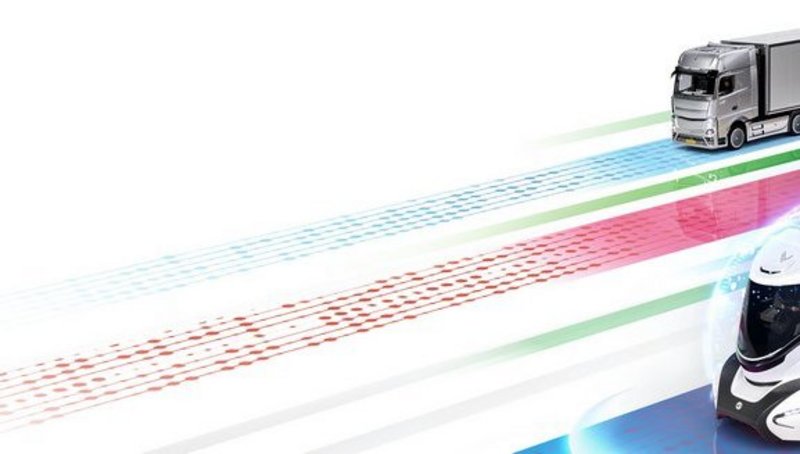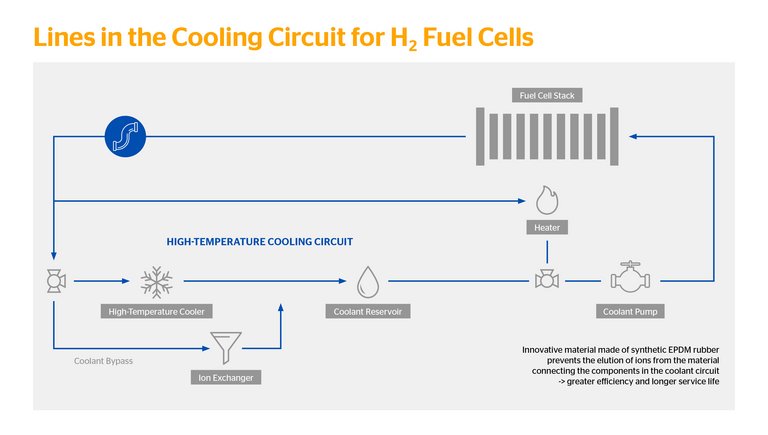No Way Out for Ions: Continental Introduces Solution for One of the Greatest Hydrogen Challenges
- Innovation in hydrogen system lines reduces ion leaching
- Greater efficiency, less material wear: reduction in leaching of ions enables significant technological improvements in hydrogen trucks and buses
- New ContiTech Original Equipment Solutions business area is pooling expertise in media circuits and supporting OEMs with the production of new types of drive system
Hanover, Germany, February 11, 2025. Continental has developed a line for cooling in the hydrogen powertrain of commercial vehicles, which considerably reduces the penetration of ions into the media circuit. The synthetic rubber line has a mixture of materials whose special properties make them less susceptible to the leaching of ions from the line material. This reduces the transfer of ions into the cooling circuit of hydrogen drive systems. The material experts from the group sector ContiTech have solved one of today’s greatest challenges in the industrialization of this still least common alternative form of drive system. The product innovation increases the service life of vehicle components in hydrogen drive systems.
Material made of synthetic EPDM rubber reduces ion leaching
If ions from the line material enter the cooling circuit, this can lead to degradation of the material. In turn, this reduces efficiency and increases the risk of a short circuit or leakage currents in the fuel cell. Washed out ions can, for example, damage the proton exchange membrane (PEM) and shorten its lifespan.
To combat this, Continental is using a mixture of synthetic rubber for cooling in the hydrogen circuit of commercial vehicle drive systems. More specifically, it is a special mixture based on high- performance EPDM (ethylene-propylene diene rubber) that offers the necessary high resistance against the unwanted leaching of ions.
High-density hydrogen line thanks to a special thermoplastic barrier
As part of the move away from oil and gas, many bus and truck fleets as well as commercial vehicle manufacturers are pinning their hopes on hydrogen as a source of energy for drive systems. However, compared to the use of battery-generated drive energy, engineers in the vehicle industry currently still face a large number of challenges when it comes to hydrogen.
The extremely low density of hydrogen atoms also presents problems for developers. Harald Kreidner, Head of Research and Development at ContiTech business area OESL, explains: "Permeation resistance, anti-static and high pressure are challenging requirements. We are combining our material expertise so we can tailor elastomers, thermoplastics and metals for use in hydrogen powertrains." As the smallest molecule with the lowest density, hydrogen is so light and volatile that conventional lines do not form a barrier.
In the fuel circuit of hydrogen-powered commercial vehicles, Continental is addressing this challenge with a hose construction featuring a thermoplastic barrier layer, which prevents the hydrogen atoms from being released, despite their low density. This guarantees the safe operation of the vehicle, as it minimizes the probability of a flammable hydrogen-air mixture occurring in the area of the hydrogen-carrying line. In addition, the range of the fuel-cell vehicle is increased, as the loss of fuel is reduced.
Continental’s USP: material expertise paired with combustion engine experience
"In the OESL business area, we have decades of experience as a system partner for media circuits and engine mounts in combustion technology. Our customers benefit hugely from this experience and the joint development of lines, splices and mounting components for hydrogen and battery drive systems in commercial vehicles," explains Mark Klein-Hietpas, Director CV sales in the OESL business area at Continental. "As with combustion technology, we have also succeeded in finding the materials and material compounds that can cope with the sometimes contradictory requirements for hydrogen and battery circuits. Our research and development in this area bridges the gap and transfers and adapts existing technologies to new forms of drive systems."
If, for example, a high level of imperviousness is required, but the lines also need to be flexible, it takes material expertise as well as application experience to find a technically suitable solution that can also be industrialized economically. Continental has pooled its expertise in vehicle media circuits in its new business area, Original Equipment Solutions (OESL) within the ContiTech group sector in order to offer integrated support for the commercial vehicle industry as a transformation and development partner. For this reason, this organizational unit is currently being made independent, with the aim of giving it the necessary freedom to support vehicle manufacturers in the dynamic development of combustion technology.


